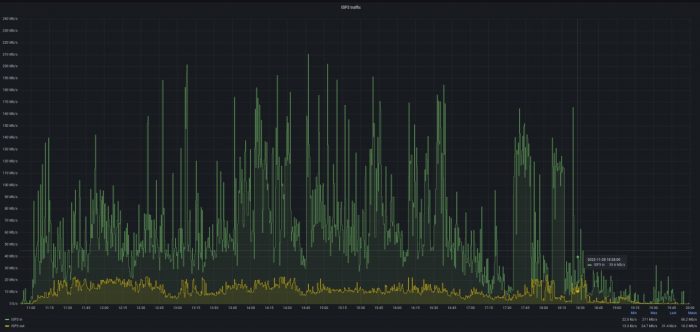The results of Starlink testing at Onix’s office
(prepared by the infrastructure administrator)
Starlink testing took place on November 28 from 11:00 a.m. to 8:00 p.m.
According to statistical data, 180-200 unique IP addresses participating in the testing.
During the testing, they downloaded 219 GB and transmitted 39 GB of data. This amounts to 258 GB of data, nearly 200 GB less than the average daily traffic consumption.

The highest recorded download speed was 211 Mbps; the highest recorded upload speed was 24.7 Mbps.
The average broadband speed was 56.2 Mbps and 10.2 Mbps, respectively.
No unavailability of the IP service was recorded during the testing.
Uplink restrictions can be considered the primary limiting factor that caused the decreased amount of consumed traffic compared to the average daily consumption.
The MikroTik router’s average CPU utilization was around 8.7%, and the number of NAT sessions was around 13,400. Normally, the CPU load would be 14.1%, and the number of NAT sessions would be 7,540 during the same period. This means that a router operating through Starlink maintains more sessions with a lower CPU utilization.
5 complaints from colleagues regarding Internet access through Starlink were recorded during the testing:
- Serhii — unable to push to git with “broken pipe” error
- Kostiantyn — AWS interface opening slowly; interrupted SSH sessions
- Denis — unable to upload a build to the Apple app store
- Valeriy — interrupted web requests; incomplete UI elements loading; pages loading slowly
- Oleg — unable to push to git with “broken pipe” error
Some colleagues did not complain but switched to mobile Internet.
I also noticed problems when opening web pages. When clicking links provided by Google Search, an empty page would open occasionally, so I had to refresh it by pressing F5 in the browser. No problems with external SSH connections were detected.
I can conclude that an Internet connection via Starlink is not suitable for continuous use by many users conducting web testing, using Web API, actively working with Git repositories, and uploading/downloading large volumes of data. It is a legitimate solution for emergencies when other types of Internet access are unavailable. Starlink’s limitations can be mitigated by reducing the number of users relying on one Starlink and segmenting users by different Starlink terminals so that each group (or person) is allocated a small but guaranteed band (as Starlink allows) ranging from 0.5-1 Mbps.
The absence of complaints about using video conferencing during the testing period is also noteworthy.




